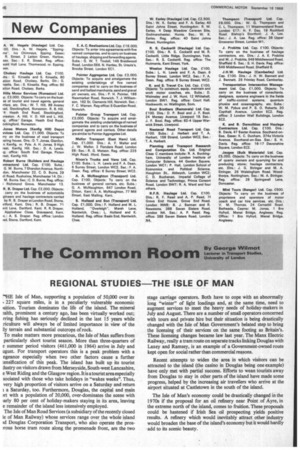REGIONAL STUDIES-THE ISLE OF MAN
Page 194

If you've noticed an error in this article please click here to report it so we can fix it.
"HE Isle of Man, supporting a population of 50,000 over its 227 square miles, is in a peculiarly vulnerable economic Isition. Tourism dominates the life of the island. The mineral .1.-alth, prominent a century ago, has been virtually worked out; rring fishing has seriously declined in the last 15 years while riculture will always be of limited importance in view of the ly terrain and substantial outcrops of rock.
To make matters more precarious, the Isle of Man suffers from particularly short tourist season. More than three-quarters of e summer period visitors (461,000 in 1964) arrive in July and ugust. For transport operators this is a peak problem with a ngeance especially when two other factors cause a further tensification of this peak. The island has built up its tourist dustry on visitors drawn from Merseyside, South-west Lancashire, e West Riding and the Glasgow region. kis a tourist area especially sociated with those who take holidays in "wakes weeks". Thus, very high proportion of visitors arrive on a Saturday and return a Saturday, too. Furthermore, Douglas, the capital and main a-t with a population of 20,000, over-dominates the scene with :arly 80 per cent of holiday-makers staying in its area, leaving e remainder of the island less intensively employed.
The Isle of Man Road Services (a subsidiary of the recently closed le of Man Railway) whose services range over the whole island id Douglas Corporation Transport, who also operate the prosTons horse tram route along the promenade front, are the two stage carriage operators. Both have to cope with an abnormally long "winter" of light loadings and, at the same time, need to augment services to meet the heavy needs of holiday-makers in July and August. There are a number of small operators concerned with tours and private hire but their situation is being drastically changed with the Isle of Man Government's belated step to bring the licensing of their services on the same footing as Britain's. These licensing changes became law last year. The Manx Electric Railway, really a tram route on separate tracks linking Douglas with Laxey and Ramsey, is an example of a Government-owned route kept open for social rather than commercial reasons.
Recent attempts to widen the area in which visitors can be attracted to the island (the casino in Douglas being one example) have only met with partial success. Efforts to wean tourists away from Douglas to stay in other, parts of the island have made some progress, helped by the increasing air travellers who arrive at the airport situated at Castletown in the south of the island.
The Isle of Man's economy could be drastically changed in the 1970s if the proposal for an oil refinery near Point of Ayre, in the extreme north of the island, comes to fruition. These proposals could be hastened if Irish Sea oil prospecting yields positive results. A refinery which would inevitably attract other industry would broaden the base of the island's economy but it would hardly add to its scenic beauty.




















































































































































































































































































